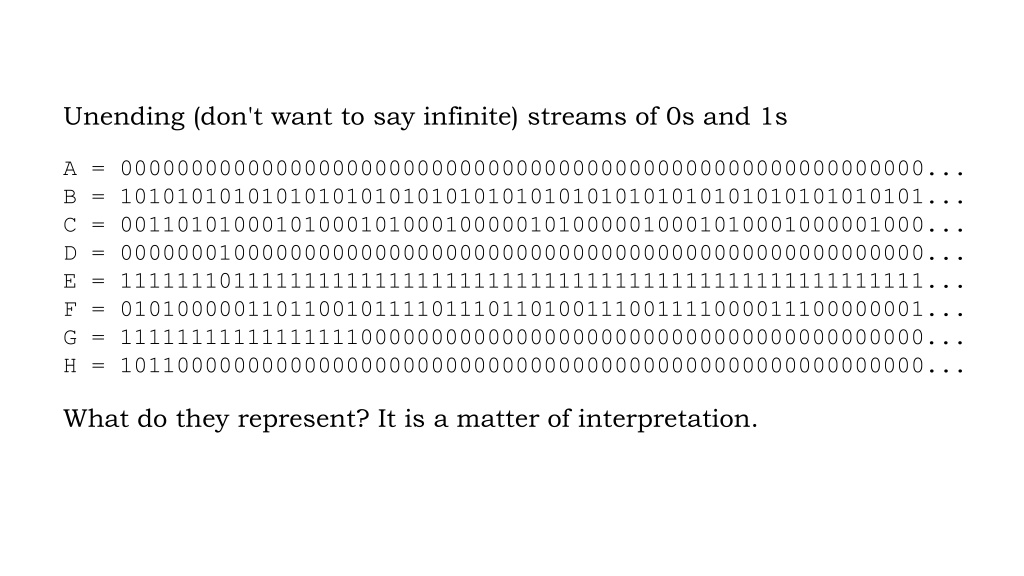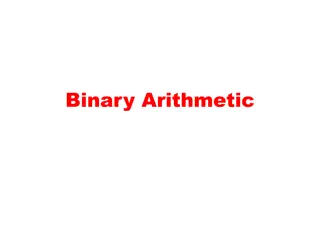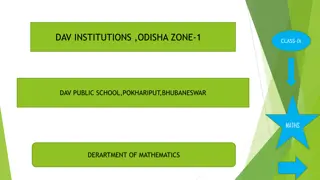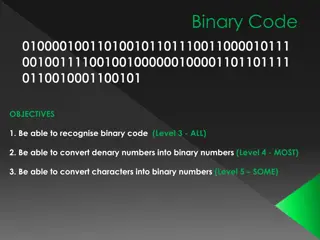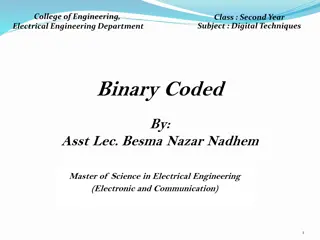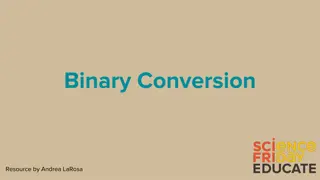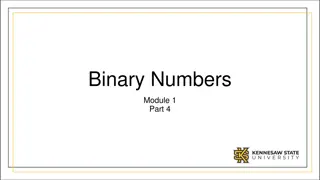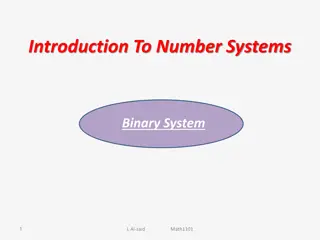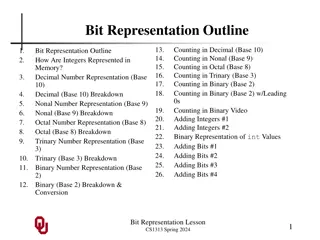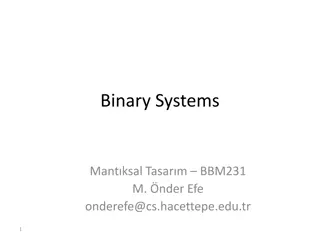Understanding Binary Numbers and Their Representation in Mathematics
Explore the world of binary numbers through a series of infinite 0s and 1s, representing integers and real numbers between 0 and 1. Dive into the interpretation of these binary sequences as natural numbers, integers, and fractions, shedding light on the concepts of trans-finite numbers and their place in mathematics.
Download Presentation

Please find below an Image/Link to download the presentation.
The content on the website is provided AS IS for your information and personal use only. It may not be sold, licensed, or shared on other websites without obtaining consent from the author. Download presentation by click this link. If you encounter any issues during the download, it is possible that the publisher has removed the file from their server.
E N D
Presentation Transcript
Unending (don't want to say infinite) streams of 0s and 1s A = 000000000000000000000000000000000000000000000000000000000... B = 101010101010101010101010101010101010101010101010101010101... C = 001101010001010001010001000001010000010001010001000001000... D = 000000010000000000000000000000000000000000000000000000000... E = 111111101111111111111111111111111111111111111111111111111... F = 010100000110110010111101110110100111001111000011100000001... G = 111111111111111110000000000000000000000000000000000000000... H = 101100000000000000000000000000000000000000000000000000000... What do they represent? It is a matter of interpretation.
A = 000000000000000000000000000000000000000000000000000000000... B = 101010101010101010101010101010101010101010101010101010101... C = 001101010001010001010001000001010000010001010001000001000... D = 000000010000000000000000000000000000000000000000000000000... E = 111111101111111111111111111111111111111111111111111111111... F = 010100000110110010111101110110100111001111000011100000001... G = 111111111111111110000000000000000000000000000000000000000... H = 101100000000000000000000000000000000000000000000000000000... See them as binary numbers, and they represent integers. Except only zero and infinite numbers are possible, and we're still deciding on the status of infinite numbers.
A = 000000000000000000000000000000000000000000000000000000000... B = 101010101010101010101010101010101010101010101010101010101... C = 001101010001010001010001000001010000010001010001000001000... D = 000000010000000000000000000000000000000000000000000000000... E = 111111101111111111111111111111111111111111111111111111111... F = 010100000110110010111101110110100111001111000011100000001... G = 111111111111111110000000000000000000000000000000000000000... H = 101100000000000000000000000000000000000000000000000000000... See them as binary numbers written backwards, and they represent integers, including infinite ones. H is 13 (11012) D is 128 G is 131071
Integer or Natural Number? Really we are dealing with natural numbers, negatives are not part of it. But trans-finite numbers can not really be called natural, And in this particular area integer is the normal term
A = 000000000000000000000000000000000000000000000000000000000... B = 101010101010101010101010101010101010101010101010101010101... C = 001101010001010001010001000001010000010001010001000001000... D = 000000010000000000000000000000000000000000000000000000000... E = 111111101111111111111111111111111111111111111111111111111... F = 010100000110110010111101110110100111001111000011100000001... G = 111111111111111110000000000000000000000000000000000000000... H = 101100000000000000000000000000000000000000000000000000000... Assume a decimal (binary really) point at the left, and they are real numbers between 0 and 1, like before with decimal. B, 0.101010101010... is the fraction 2/3 D, 0.00000001 (assume the rest is all zeros) is 0.00390625 E, 0.111111111111... is as close as 1 as we can get H, 0.1011 is 0.6875
A = 000000000000000000000000000000000000000000000000000000000... B = 101010101010101010101010101010101010101010101010101010101... C = 001101010001010001010001000001010000010001010001000001000... D = 000000010000000000000000000000000000000000000000000000000... E = 111111101111111111111111111111111111111111111111111111111... F = 010100000110110010111101110110100111001111000011100000001... G = 111111111111111110000000000000000000000000000000000000000... H = 101100000000000000000000000000000000000000000000000000000... See them as bitmaps (1 = present, 0 = absent) and they are sets of natural numbers H, 110100000000... is { 0, 1, 3 } B, 101010101010... is all the even numbers, { 0, 2, 4, 6, 8, ... } E, 111111111111... is all of the natural numbers C, 001101010001... is the prime numbers { 2, 3, 5, 7, 11, ...}
An interesting thing: Sets of natural numbers and Real numbers, 0 <=x< 1 Are in some way the same thing. Power sets, (S), 2S
A = 000000000000000000000000000000000000000000000000000000000... B = 101010101010101010101010101010101010101010101010101010101... C = 001101010001010001010001000001010000010001010001000001000... D = 000000010000000000000000000000000000000000000000000000000... E = 111111101111111111111111111111111111111111111111111111111... F = 010100000110110010111101110110100111001111000011100000001... G = 111111111111111110000000000000000000000000000000000000000... H = 101100000000000000000000000000000000000000000000000000000... Almost identically, they are properties of integers B, 101010101010... is all the evenness property H, 110100000000... is the property of being a member of the set { 0, 1, 3 } E, 111111111111... is existence property C, 001101010001... is the primality property
A = 000000000000000000000000000000000000000000000000000000000... B = 101010101010101010101010101010101010101010101010101010101... C = 001101010001010001010001000001010000010001010001000001000... D = 000000010000000000000000000000000000000000000000000000000... E = 111111101111111111111111111111111111111111111111111111111... F = 010100000110110010111101110110100111001111000011100000001... G = 111111111111111110000000000000000000000000000000000000000... H = 101100000000000000000000000000000000000000000000000000000... Almost identically again, they are Integer Decision Functions, Functions that make decisions (return true or false) about natural numbers bool B(int n) { return n % 2 == 0; } bool G(int n) { return n < 17; } bool E(int n) { return true; }
By function I mean "Total Function" in the mathematical sense, a mapping from inputs to outputs. This is a function in the programming sense, but not in the mathematical sense: bool decide(int n) { if (n == 0) return false; else if (n == 1) return true; else if (n % 3 == 0) return decide(n * 3); else return decide(n / 2); }
Those things: Unending streams of zeros and ones Integers including trans-finite ones Real numbers between 0 and 1 Sets of natural numbers Integer decision functions are in some real way the same. Each can represent any of the others. They convey the same amount of information.
Integer Decision Functions (IDFs) fundamentally important. They represent things we might want to compute. More than one input? bool isbigger(int a, int b) { return a > b; } No problem: ... bool isbigger(int n) { (a, b) = anticantor(n); return a > b; } if (isbigger(s, 3)) ... ... if (isbigger(cantor(x, 3))) ...
Non-boolean result? int square(int n) { return n * n; } No problem: ... bool issquare(int n, int s) { return n * n = s; } s = square(a + 3); ... s = 0; while (! issquare(a + 3, s) s += 1; These two tricks are often combined of course
Sometimes a bit-by-bit approach is preferrable int calculate(int n) { // anything could be // happening in here return r % 8; } bool IDFcalculate(int n) { (d, n) = anticantor(n); v = calculate(n); if (d == 0) return (v & 1) == 1; if (d == 1) return (v & 2) == 1; if (d == 2) return (v & 4) == 1; } ... ... x = IDFcalculate(cantor(2 * w, 0)) + 2 * IDFcalculate(cantor(2 * w, 1)) + 4 * IDFcalculate(cantor(2 * w, 2)) + x = calculate(2 * w);
Imagine we have an enumeration for IDFs. We don't need to be told anything about it, we know it must look like [ IDF0, IDF1, IDF2, IDF3, IDF4, IDF5, ... ] V(x, y) represents the value of IDFx(y) I could think of a big table: V(0,0) V(1,0) V(2,0) V(3,0) V(4,0) V(5,0) V(6,0) ... V(0,1) V(1,1) V(2,1) V(3,1) V(4,1) V(5,1) V(6,1) ... V(0,2) V(1,2) V(2,2) V(3,2) V(4,2) V(5,2) V(6,2) ... V(0,3) V(1,3) V(2,3) V(3,3) V(4,3) V(5,3) V(6,3) ... V(0,4) V(1,4) V(2,4) V(3,4) V(4,4) V(5,4) V(6,4) ... V(0,5) V(1,5) V(2,5) V(3,5) V(4,5) V(5,5) V(6,5) ... V(0,6) ... V(1,6) ... V(2,6) ... V(3,6) ... V(4,6) ... V(5,6) ... V(6,6) ... ... ...
V(0,0) V(1,0) V(2,0) V(3,0) V(4,0) V(5,0) V(6,0) ... V(0,1) V(1,1) V(2,1) V(3,1) V(4,1) V(5,1) V(6,1) ... V(0,2) V(1,2) V(2,2) V(3,2) V(4,2) V(5,2) V(6,2) ... V(0,3) V(1,3) V(2,3) V(3,3) V(4,3) V(5,3) V(6,3) ... V(0,4) V(1,4) V(2,4) V(3,4) V(4,4) V(5,4) V(6,4) ... V(0,5) V(1,5) V(2,5) V(3,5) V(4,5) V(5,5) V(6,5) ... V(0,6) ... V(1,6) ... V(2,6) ... V(3,6) ... V(4,6) ... V(5,6) ... V(6,6) ... ... ... and construct ~V(0,0) ~V(1,1) ~V(2,2) ~V(3,3) ~V(4,4) ~V(5,5) ~V(6,6) ... an IDF, call it NewIDF such that NewIDF(x) = ~IDFx(x)
